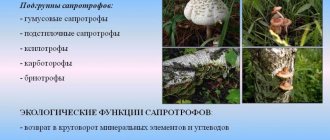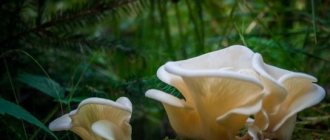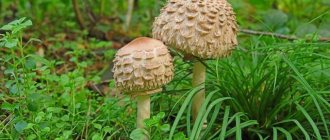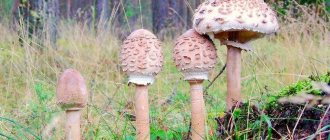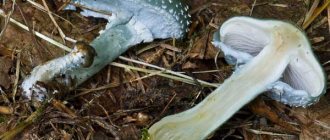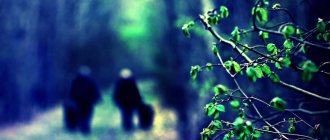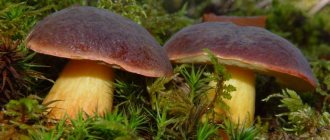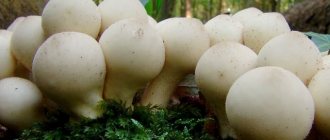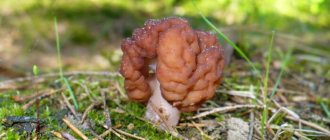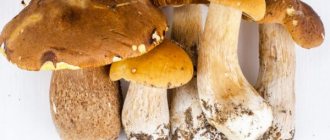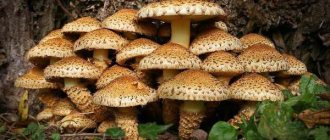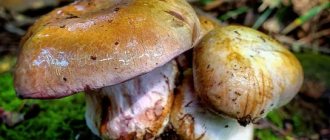Umbrella mushrooms are the colloquial name for the genus Macrolepiota, which belongs to the Champignon family. Among the mushrooms called “umbrellas,” there are both edible and inedible species. Umbrellas belong to the Basidiomycota class of Agaricomycetes. They got their name due to their elongated stem and dome-shaped cap. The most common of all the umbels is the variegated umbel (Macrolepiota procera), an edible mushroom with a pleasant nutty flavor. Sometimes other mushrooms belonging to similar genera (Lepiota, Chlorophyllum, Cystoderma) are also called umbrellas. When collecting, you should remember that some mushrooms are listed in the Red Book and may also be protected by regional books on rare species, including the maiden umbrella mushroom, which cannot be collected in almost the entire territory of the Russian Federation.
What it looks like and where it grows
The umbrella mushroom is found on almost all continents, with the exception of Antarctica. It is difficult not to notice, as its shape and size immediately catch the eye. Usually this lover of light forests and open meadows grows to a respectable size. When fully opened, its hat resembles an open umbrella, rising on a long white stem. This mushroom just begs to be picked up and children especially often show interest in it, sometimes confusing edible and inedible varieties.
Given this, it is very important that mushroom hunting takes place under the supervision of experienced adults. But this mushroom is insidious in that it can be found not only in the forest, but also in any open clearings, even in garden plots. If such an umbrella mushroom has grown right in the garden, the main thing is to correctly determine whether it is an edible specimen or a toadstool. The edible mushroom has many subspecies, but toadstools also have a whole army of similar false varieties. Edible umbrellas are a type of champignon and have a pleasant taste and aroma. But this, of course, does not mean that they should be eaten raw.
The Latin name for the mushroom is macrolepiote, which is formed from two words: “macro” (meaning “large”) and “Lepiota” (denoting a genus of mushrooms). It is no coincidence that the word “macro” appeared in the name; the edible umbrella mushroom is, as a rule, of impressive size. It can grow to a height of 40 cm with a cap diameter of up to 35 cm.
It is interesting that the cap does not immediately take on the appearance of an umbrella; at first it has a spherical shape and opens only over time.
Is an umbrella poisonous or not?
It all depends on whether the right type of mushroom ends up in the basket of a lover of “quiet hunting”. A general rule that helps distinguish a toadstool from an edible variety is this: a true umbrella mushroom, or parasol, is usually large in size.
Frail little umbrellas on thin stems are most often toadstools. But still, in order not to make a mistake in choosing, it is better to get acquainted with the appearance of umbrellas in more detail.
Edible species
Edible varieties are somewhat similar to each other, but at the same time they have some differences. Each species has its own, sometimes quite elegant and unexpected name.
- Graceful (or subtle). Distributed in most European countries, grows in light, open forests, often found in grass. It grows singly and in dense groups; it is most often collected in late summer - early autumn. It reaches a height of 10−15 cm, the diameter of the cap is up to 15 cm. The cap has the shape of a cone; in its mature state it opens and becomes almost flat. The stem is thin, often curved, thickened at the base, with a “skirt” closer to the cap.
- Field (white). A lover of steppes and open mixed forests, it is found in meadows, pastures and pastures. They are collected throughout the summer, until mid-autumn. The cap is thick, fleshy, initially ovoid in shape, then cone-shaped. The surface of the cap is scaly, with a dark tubercle in the center, the color is whitish-beige, with uneven edges. Diameter - up to 12 cm. The leg has a height of 6-10 cm, is whitish-yellow, has a “skirt”, and is hollow inside. This species can easily be confused with the stinking fly agaric, so inexperienced mushroom pickers need to be especially careful.
- Conrad. Often found in forests and parks, prefers grassy meadows. The cap is thin along the edge, fleshy and dense in the center, has a beige-white color, a rounded ovoid-bell-shaped shape. Beige scales are scattered throughout the cap. Its size is up to 10 cm. The leg at the bottom is thick, beige-brown, up to 10-15 cm high, and has a wide movable “skirt”.
- Variegated (large, tall). One of the largest varieties. It is found on the edges, in sandy forests, prefers open light areas, and does not shy away from gardens, parks, meadows and pastures. You can collect from June to November. This giant has a height of up to 40 cm, and the cap can reach a diameter of 30-35 cm. Young mushrooms have a spherical cap, which opens over time. The leg is brown-brown, with a “skirt”.
- Mastoid. Loves beech and oak forests. Found from early summer to mid-autumn. The hat has a diameter of up to 10-12 cm, it is beige-coffee in color, with edges curved upward. Scales are scattered throughout the cap, closer to the edge. The height of the leg does not exceed 16 cm. It is hollow, has a brownish color on the outside, thickened at the base, with a “skirt”.
- Maiden. One of the most elegant varieties, although small in size. Grows in light pine and mixed forests. The cap is 7-10 cm in diameter, it is cone-shaped or ovoid, light in color, with many folding beige scales. If you separate the cap from the stem, then at the point of separation it will acquire a reddish color. The height of the leg is up to 16 cm, it is beige and has a “skirt”.
- Blushing (shaggy). Loves fertile soils and open spaces. The cap can be quite large, from 10 to 20 cm in diameter. When cut, it acquires a red-brown color, and when pressed it turns orange. The leg is up to 15 cm high, thickened at the base, light or brownish in color. Grayish scales are scattered sloppily across the cap. The leg has a movable “skirt”.
Read also: Talking mushrooms: description, how to distinguish from false ones, cook, gray, edible, poisonous, inedible, photo, video
Poisonous representatives
Poisonous umbrellas, as well as other mushrooms that can easily be confused with an edible umbrella, pose a very high danger. There are many such varieties, and knowing them by sight is important for any mushroom picker who values his health:
- Lepiota chestnut. A small mushroom with a brownish-chestnut cap. The height is about 7 cm, the diameter of the cap is no more than 4 cm. The cap has many scales and a thin and uneven edge. The leg is white, thin, most often without a ring.
- Lepiota rough (sharp-scaled). The cap is large, sometimes up to 15 cm in diameter, beige, with a large number of sharp brown scales, bent straight up. The leg is up to 12 cm high, light yellow, yellowish-brown with age, and has a filmy ring.
- Lepiota comb (silverfish). The hat is thin, whitish-beige, medium-sized (up to 5 cm in diameter), slightly torn along the edge. There is a brown spot in the center of the cap, and ocher-orange scales are scattered across its surface. The height of the leg reaches 8 cm, it is thin and hollow inside. The narrow ring on the stem quickly disappears.
- Chlorophyllum is dark brown and lead-slag. The light cap has beige scales, it is convex, up to 30 cm in size. The height of the stem reaches 25 cm, it has a ring, and when damaged it becomes brown. The cap may turn reddish when cut. The plates turn yellow when pressed.
- The fly agaric is smelly and panther-like. The stinking fly agaric or pale toadstool has a pale cap without scales or is covered with small flakes. The cap is convex, almost flat with age. The stem has a height of up to 15 cm. The mushroom has an unpleasant chlorine odor. The panther fly agaric is similar in appearance to the red fly agaric, only it has not a red but a grayish cap with the same scales as the red fly agaric. Both mushrooms are deadly poisonous.
Umbrella mushrooms, edible and poisonous, are distributed everywhere, so it is very easy to come across both while walking through a park, forest, meadow, or even your own summer cottage.
Whether to collect edible varieties or not is a personal matter for everyone, but those who still decide to put these saprotrophs in their basket should carefully examine each specimen to see if it matches the edible samples.
Edible types of umbrellas
Of the variety of species, the most popular as an object of collection and preparation are the following: motley, blushing and white. All of them are edible and fall into the fourth category. Despite their common belonging to the genus Macrolepiota, similar outlines and proportions of the fruiting body, they also have a number of differences. The description will help you find out what they look like.
White umbrella mushroom (Macrolepiota excoriata), also known by the following names: field or meadow umbrella.
As follows:
- At the beginning of development, the cap has a rounded shape; as it grows, it opens up and reaches 10 cm in diameter. The surface is formed by small scales, dry, with a matte texture, white at the edges and brown in the center. The cuticle is cracking;
- loose pulp does not change its milky color when cut, with a tart odor and taste;
- free plates with a cartilaginous collarium are easily separated from the cap. At the beginning of growth they are white, then pinkish;
- spores are smooth, elliptical in shape;
- the leg is hollow inside, low, up to 10 cm, about 1 cm thick, can be smooth along the entire length, or with a slight thickening at the base. The surface is smooth, milky in color, below the ring it is yellow. When pressed it becomes slightly brown in color. At the top there is a movable membranous white ring.
Blushing
Blushing umbrella mushroom (Macrolepiota phacodes), otherwise it is also called shaggy umbrella or chicken coop.
- The cap is spherical in shape at an early age, straightens out during growth and reaches about 20 cm in diameter. The texture is rough due to many rectangular creamy pink or brown scales. In the center of the cap there is a wide brownish tubercle without scales;
- The pulp is loosely fleshy, initially white, turns red when cut, its smell and taste are neutral. The cap is tender, the stalk is hard-fibrous;
- the plates are light, attached to a cartilaginous ring at the junction of the cap and the stalk (collarium). When touched, they turn carrot-colored;
- spores oval, smooth;
- a beige or light brown leg about 2 cm thick, quite high, reaching 25 cm, hollow inside, and has a tuberous swelling near the soil. At the top there is a filmy grayish-white ring.
Read also: Boletus mushroom (51 photos): description, types, where it grows, what it looks like, preparation, benefits, properties, video
The variegated umbrella mushroom (Macrolepiota procera), also popularly known as large or tall umbrella.
- It got its name, “variegated,” because of the many brownish angular scales covering a very large cap, 25-30 cm in diameter. As it grows, its shape acquires noticeable changes: ovoid at the beginning of development turns into bell-shaped in the middle phase and fully opens in mature specimens. The main color is gray with shades of brown, darkening towards the center, where there is a pronounced tubercle. The surface is dry to the touch;
- the pulp is fleshy, loose, white, with a characteristic smell and taste reminiscent of nutty;
- loose, very light plates, redden with age, separated from the stalk by a cartilaginous collarium;
- spores are smooth, elliptical in shape;
- the leg, with a thickness of about 3 cm, can reach up to 35 cm in height. The surface is covered with brown scales, hollow inside, and noticeably thickened near the base. The entire length is painted in a light brown tone. The leg has a wide filmy ring that moves easily along it.
In what forests and where do they grow?
A common property of umbrella mushrooms is their love for open, well-lit spaces and unpretentiousness to climatic conditions. Soils with sufficient humus content are important for them, since they are saprophytes that form mycorrhizae in the presence of an organic substrate.
The red umbrella mushroom can be found everywhere in Eurasia, including in the north of the temperate climate zone, in both Americas, Australia and North Africa. Grows from July to the end of October in mixed, coniferous, deciduous forests, singly or forming small colonies. In addition to its taste, it is good because it can be collected until late autumn, when there are few other mushrooms.
The variegated umbrella mushroom can usually be found in bushes and sparse forests, on the edges, clearings, and clearings. Collection time: August, September. Usually they create rows and groups. A rarer localization is “witch rings” and single specimens. Among its fellows, macrolepiot is a real giant: you can collect 5-6 of these mushrooms and no longer worry about a hearty dinner for the whole family.
The white umbrella mushroom grows in small colonies from July to early October on roadsides, clearings, meadows and pastures. It is less common than the motley umbrella and is noticeably smaller in size, but has a more pronounced smell and taste.
Interesting Facts
Umbrella mushrooms have several interesting facts that not everyone knows about:
- Fruiting bodies have a powerful bactericidal effect. Therefore, many people use dried and powdered legs to cleanse their living space of various viruses and bacteria.
- Residents of Italy call the species of the variegated umbrella mushroom “drumsticks.”
- Aqueous extract of panther fly agaric has insecticidal properties.
- The alkaloid hyoscyamine, found in the tissues of the panther fly agaric, is present in varying quantities in the tissues of different species of plants from the Solanaceae family.
Similar species and how to distinguish them from them
- The variegated umbrella is often confused with the graceful (thin) umbrella (Macrolepiota gracilenta), which is much smaller in size. This species is edible, quite suitable for collection and is also included in the fourth taste category. A mistake can be fatal if poisonous doubles get into the basket: lead-slag chlorophyllum (Chlorophyllum molybdites) and dark brown chlorophyllum (Chlorophyllum molybdites). Their main differences are: the cuticle is light, and the flesh, when pressed, acquires an orange or reddish tint.
- The blushing umbrella has an edible counterpart, the lady's umbrella (Chlorophyllum molybdites). It can be safely collected and prepared, although it is quite rare. Among the poisonous fellows, in addition to the already mentioned chlorophyllums, the poisonous lepiota (Lepiota helviola), the scaly lepiota (Lepiota brunneoincarnata) and the panther fly agaric (Amanita pantherina) are similar. The main difference between these deadly doubles is their significantly smaller size.
A novice mushroom picker may find this comparison chart useful.
Primary processing and preparation
The peculiar, slightly astringent taste of the caps of young specimens is the main advantage of all these mushrooms. It is during the period of early ripeness that it is best to collect them. They are good for frying, in broths, salads, fillings for sandwiches and pies.
Attention! Regardless of the nature of the dish in which these mushrooms are used, they must undergo heat treatment (possibly without prior boiling), even if they have just been picked.
Young umbrellas can also be pickled; they are also quite suitable for drying. It is better to ferment or pickle mature specimens.
Edible and inedible umbrella mushroom
Picking mushrooms is fun and interesting. The umbrella mushroom is a real find, it is tasty, healthy and aromatic. The peculiarity is that its pulp does not contain harmful substances, which is typical for such plants. It is best to go for umbrellas at the edge of the forest or in a field, immediately after heavy rain. Every mushroom picker should know what an edible and poisonous mushroom looks like and be able to identify their distinctive features and characteristics.
Harm and contraindications
Mushrooms should not be eaten by people with gastrointestinal problems
In some cases, these fungi can cause side effects and deterioration of the condition, so they have contraindications:
- children under 7 years of age;
- various gastrointestinal diseases - gastritis, ulcers, pancreatitis;
- pregnancy and lactation;
- individual intolerance.
It is recommended to collect umbrella mushrooms in an ecologically clean area, away from industrial zones, highways and polluted places. Because fruiting bodies that have accumulated toxins in their tissues can cause irreparable harm to your health.
Umbrella mushroom - description
The umbrella mushroom belongs to the genus Macrolepiota, the Champignon family. It got its name because of its external resemblance to an open umbrella: a large dome-shaped hat on a high and thin stem. Many species are safe and can be eaten, although the plant has several poisonous counterparts that are extremely dangerous to human health. The structure of the mushroom is typical capped, and the size can be medium to large. The flesh is dense and fleshy, the stem can bend slightly and is easily separated from the cap.
After heavy rains, umbrellas can grow to very large sizes. The cap of such a mushroom reaches a diameter of 35 to 45 cm, and the height of the stem grows to 30-40 cm.
On average, the mushroom has a stalk length of about 8-10 cm and a cap diameter of 10-15 cm. The surface of the cap is dry and finely scaly; at the edges the skin may crack and hang down in the form of a fringe. The pulp and juice are light in color with a pleasant mushroom smell and delicate taste. The leg at the base is thickened, it has a characteristic movable membranous ring. In young umbrellas, the cap is connected to the base of the stem and has a spherical shape. As it grows, it separates from the stem and opens, forming a dome with a small elevation in the center.
a brief description of
Edible mushrooms are considered a delicacy because... They have tasty and tender pulp, as well as an amazing aroma.
They received their name as a result of a combination of two Greek words - macro, which means “big”, and lepiota - “umbrella”. The fruiting body with an elongated stem and dome-shaped head looks like an open umbrella.
The description includes several distinctive qualities:
- standard structure, medium or large size, circumference 35-40 cm
- at a young age the cap is ovoid or hemispherical, in adult specimens it is expanded, convex-flattened, like a dome;
- the surface is white with a pronounced tubercle in the center; as it grows, it cracks, forming numerous scales of a light brown tone;
- the leg is erect, sometimes slightly curved, cylindrical, easily separated from the cap, tuberous at the bottom;
- in cross-section, the fruit body is fleshy, dense, and darkens when broken;
- the plates are light, densely spaced, and turn brown with age;
- in the middle the leg is ringed with a white border with corrugated edges; in adult specimens this part is multilayered.
Umbrella mushrooms are characterized by the presence of a special formation - a collarium (ring-shaped thickening), which is formed due to the fusion of the edges of the free plates of the hymenophore around the stalk.
- Umbrella mushrooms are saprophytes and settle on the soil both in the forest and beyond. Although they are not mycorrhiza-formers, they are found in the same place year after year. Although all of them are edible, some representatives of the genus are very highly valued in the markets of Europe, Asia and Africa, especially the variegated umbrella mushroom.
- Macrolepiotes are cosmopolitan and distributed almost throughout the globe. The best studied species are those of the northern temperate zone.
- It is known that the mycelium of most mushrooms develops without access to light, but the need for cap mushrooms to form full-fledged fruiting bodies is very different. In the complete absence of light or its excess, fruiting may not occur at all, or the formation of ugly fruiting bodies that are not capable of forming spores will occur.
They grow in different climatic conditions and are distributed almost everywhere - in America, Asia, Africa, Australia, Mexico. In our country they prefer to grow in regions with a temperate climate. The collection is carried out in the summer-autumn period.
Types of umbrellas
The umbrella mushroom is considered widespread; it grows in coniferous, deciduous and mixed forests, found in fields and forest edges, in steppes and meadows, in gardens, orchards and nature reserves.
Read also: Row mushroom (50 photos): poplar, gray, green, edible and inedible, description, cap, what they look like, how to close
Umbrella mushroom photo - edible and poisonous:
- White or field umbrella. The mushroom is edible and widespread. Grows in steppes and pastures, along clearings and forest edges. Representatives of the species reach small sizes - the diameter of the cap is in the range of 5-10 cm. The skin is thin, whitish-grayish in color. The center of the cap is raised and smooth, darker in color, with flakes hanging along the edge. The leg is hollow, slightly thickened at the base. It is a Chinese delicacy, but be careful not to confuse it with the fly agaric, which is deadly poisonous. The main difference between the fly agaric is the mucus that covers the cap and the membranous covering around the stem.
- The umbrella is red or shaggy. An edible species that prefers nutritious soil rich in humus. When pressed and cut, the pulp instantly oxidizes, becoming reddish-brown. The edge of the cap of a young mushroom is first tucked in, and then straightens out, becoming covered with cracks. The color of the cap can be beige or gray, the arrangement of the scales is circular, the middle is raised and has a dark color. It can be confused with the rough umbrella, an extremely poisonous member of the family. Mushroom pickers distinguish the inedible representative by the pungent odor and pungent taste of the pulp.
- The umbrella is motley or large. The mushroom is edible, preferring open and illuminated areas near forests. The growth period is from early summer to late autumn, found singly or in rare families. It is large and fleshy, the thickness of the leg can reach from 1 to 3 cm, the diameter of the cap varies from 10 to 30 cm. The color of the cap is brown-gray with angular scales and a clearly visible dark elevation in the middle. The stem is brown; in older plants it may be covered with well-defined scales.
Place and time of growth
Where does the umbrella specimen grow? Home for umbrellas are forests, plantings, onions, fields, steppes and places where sunlight easily penetrates, because most varieties are typical saprotrophs. Specimens can be found in forest clearings, forest edges, and areas along clearings. Individuals can be found on any continent, with the exception of Antarctica.
The fruiting season can be considered the period from the beginning of summer to the end of September.
Edible mushroom and poisonous counterparts
The difficulty in collecting umbrellas is that there are their poisonous counterparts. Outwardly, they look like edible umbrellas, but contain toxic substances, so their consumption is prohibited.
All umbrella doubles are deadly poisonous and threaten human life. When collecting umbrella mushrooms, you should be attentive and careful, as it is very easy to confuse a false mushroom with a real one. Most inedible mushrooms emit an unpleasant odor and have a bitter taste.
Umbrella mushroom - photo and description, poisonous counterparts:
- Chlorophyllum is dark brown. The mushroom is poisonous and reaches medium size. Outwardly it resembles an umbrella, but is fleshier and shorter. At the base of the leg there is a characteristic tuberous growth that rises above the surface of the ground. The pulp is white, in places of cuts and damage it immediately acquires a reddish tint. The mushroom contains a hallucinogenic toxin; its effect on the nervous system has not been fully studied.
- The fly agaric is smelly. Eating any type of fly agaric is deadly; the poison leads to death in 90% of cases and severe poisoning in 10% of cases. The entire body of the mushroom is smooth and has a whitish-gray color. The leg is tall and thickened at the very base. It is covered with plaque, and the ring characteristic of an umbrella is missing. The pulp is light and does not change color. The stinking fly agaric has an unpleasant chlorine odor.
- Chlorophyllum lead-slag. The mushroom is poisonous, has an external resemblance to an umbrella, and reaches large sizes. In young plants, the body structure is spherical; in adults, the cap opens up and becomes almost flat. The characteristic difference between a poisonous and an edible mushroom is the stem. In the inedible representative it is completely smooth, with a fixed ring in the upper part.
Collection rules
When going on a quiet hunt, you need to take with you a sharp knife, a wicker basket and a stick to search for fruiting bodies.
We collect umbrella mushrooms like this: we cut off the stem at the very base so that part remains in the ground. Next year it will give a new harvest.
We shake off the harvested crop from forest debris and carefully place it in a basket with the caps down.
To prepare delicious mushroom dishes, give preference to young specimens, whose flesh is tender and rich in flavor.
How to properly prepare umbrellas
Umbrellas, like many other mushrooms, are healthy and nutritious and should be collected young, when the cap is not yet fully opened. Mature representatives may begin to feel bitter. How to cook umbrella mushrooms? The stem is removed, and the cap must be subjected to heat treatment - fried, boiled, stewed, pickled, salted. Umbrellas can be pre-dried or frozen, and then used to prepare a wide variety of dishes - soups, appetizers, salads, baking fillings and pancakes.
Umbrella mushrooms should not be collected near industrial enterprises, garbage dumps, large highways and railroad tracks. They can accumulate harmful and dangerous substances that threaten human health and life.
Umbrella mushroom recipes:
- a large umbrella cap is cleared of scales and washed well, salt and pepper to taste, and then fried on both sides in vegetable oil - simple and very tasty;
- you can fry the caps, previously dipped in batter, or rolled in breadcrumbs or flour, this is original and quick;
- special fans cook grilled umbrellas on the grill of an oven or outdoor barbecue, marinating them briefly in lemon juice with herbs and garlic, an interesting and affordable option;
- dry and aromatic umbrella cooks quickly, it is good for broth, as an additional ingredient for appetizers and sandwiches.
The unique taste and rich mushroom aroma are the main advantages of the umbrella. Nutritionists note their unique composition and high nutritional value, content of amino acids, fiber, salts, vitamins and minerals. The beneficial mushroom is widely used in folk medicine for preventive and therapeutic purposes.
Cooking umbrella mushroom - video
Beneficial features
Young fruiting bodies are of greatest benefit to the body - they have tender, aromatic and tasty pulp.
The healing properties of the forest product are due to its rich chemical composition:
- melanin;
- arginine;
- tyrosine;
- magnesium, calcium, iron, potassium, sodium and phosphorus;
- vitamins B, C, K, E;
- beta glucans.
With this content, umbrellas are readily used in alternative medicine to prepare tinctures and extracts for various ailments. Traditional healers note the beneficial properties of mushrooms for disorders of the nervous system, cancer, rheumatism and disorders of the heart and blood vessels.
Please note. Before you engage in treatment, much less resort to alternative medicine, you must be sure of your health. Therefore, first consult with your doctor about the possibility of additional, non-traditional therapy.
The low-calorie product is excellent for dietary nutrition for people suffering from obesity and diagnosed with diabetes.
